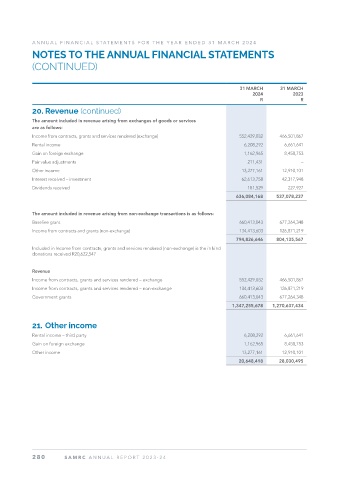Page 282 - SAMRC Annual Report 2024-2025
P. 282
ANNUAL FINANCIAL STATEMENTS FOR THE YEAR ENDED 31 MARCH 2025
SIGNIFICANT ACCOUNTING POLICIES
(CONTINUED)
1.14 Impairment of non-cash-generating assets
Cash-generating assets are assets managed with the objective of generating a commercial return. When
an asset is deployed in a manner consistent with that adopted by a profit-oriented entity, it generates a
commercial return.
Non-cash-generating assets are assets other than cash-generating assets.
Impairment is a loss in the future economic benefits or service potential of an asset, over and above the
systematic recognition of the loss of the asset’s future economic benefits or service potential through
depreciation (amortisation).
Carrying amount is the amount at which an asset is recognised in the statement of financial position after
deducting any accumulated depreciation and accumulated impairment losses thereon.
Depreciation (Amortisation) is the systematic allocation of the depreciable amount of an asset over its
useful life.
Fair value less costs to sell is the amount obtainable from the sale of an asset in an arm’s length transaction
between knowledgeable, willing parties, less the costs of disposal.
Recoverable service amount is the higher of a non-cash-generating asset’s fair value less costs to sell
and its value in use.
Useful life is either:
(a) the period of time over which an asset is expected to be used by the entity; or
(b) the number of production or similar units expected to be obtained from the asset by the entity.
Criteria developed by the annual financial statements to distinguish non-cash-generating assets from
cash-generating assets are as follows:
Assets used for administration and in daily operation of the entity is classified as non-cash-
generating assets.
Where a substantial part of the asset is hired out, the asset is classified as cash generating assets.
Identification
When the carrying amount of a non-cash-generating asset exceeds its recoverable service amount, it
is impaired.
The entity assesses at each reporting date whether there is any indication that a non-cash-generating
asset may be impaired. If any such indication exists, the entity estimates the recoverable service
amount of the asset.
This impairment test is performed at the same time every year. If an intangible asset was initially
recognised during the current reporting period, that intangible asset was tested for impairment before
the end of the current reporting period.
Value in use
Value in use of non-cash-generating assets is the present value of the non-cash-generating assets
remaining service potential.
The present value of the remaining service potential of non-cash-generating assets is determined using
the following approach:
280 SAMRC ANNUAL REPOR T 2025-26

